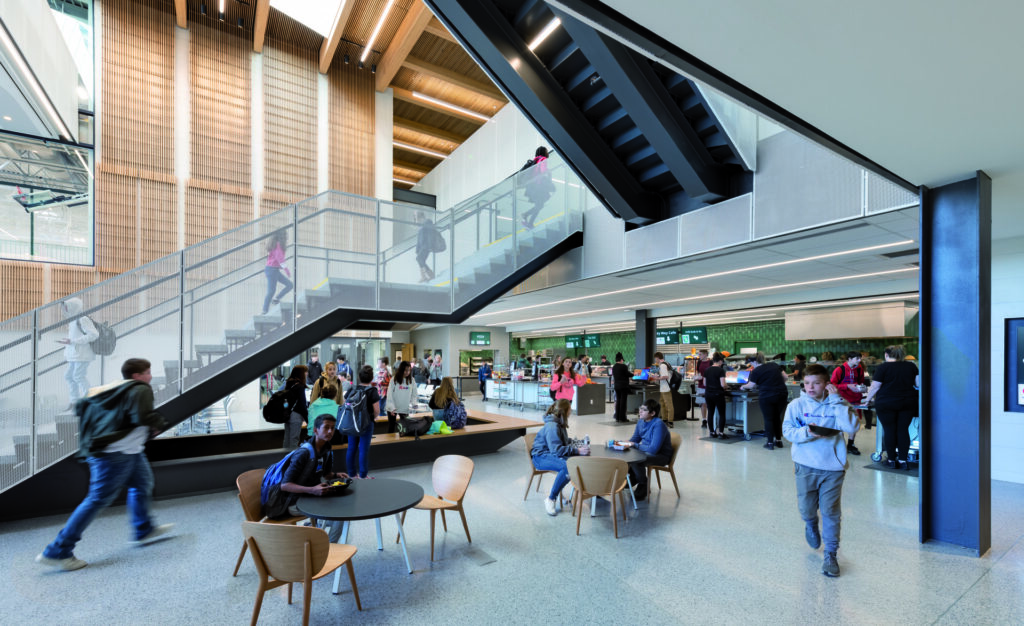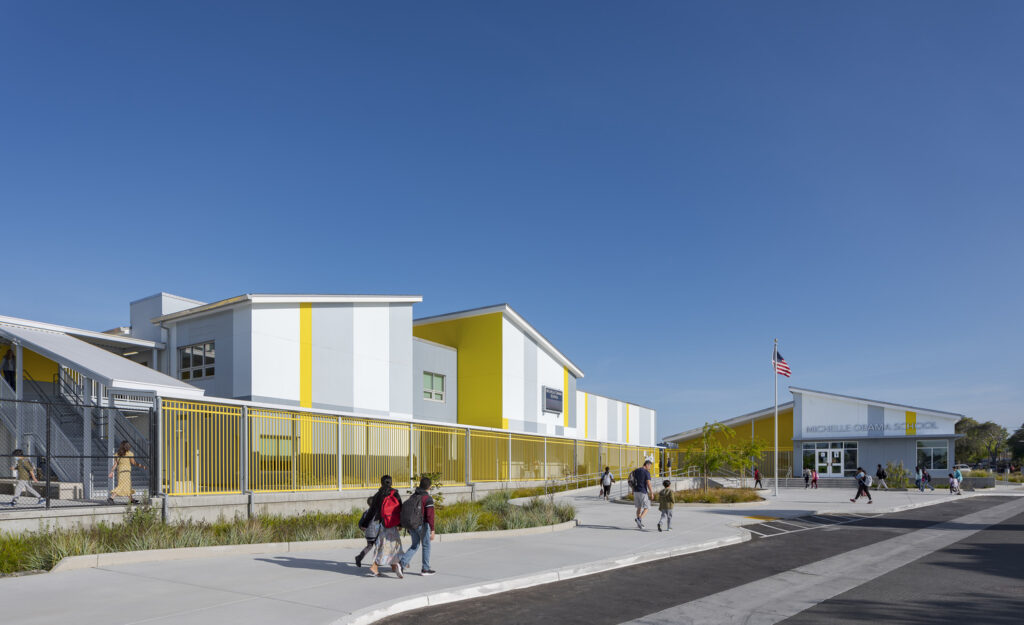K-12 schools represent a major public investment, with recent budget figures showing the United States spends about $87 billion dollars on facilities in a year. This investment includes roughly 98,000 school buildings serving over 50 million students. The extent of this investment is matched by its impact, with a recent analysis showing that community decisions to invest in their learning environments significantly raises both student test scores and local house prices. This kind of research leaves us with the question of how architects, designers, and planners can best use those resources to maximize impact. Sadly, the current picture gets very blurry very quickly as we zoom in.

A heavily cited study from Peter Barrett and co-authors found that a significant fraction of student learning progress — up to 16% — was connected to classroom design elements. For example, their study showed “student ownership” was important for student performance… but there are many ways to design for student ownership. This kind of question can guide researchers as we evaluate specific solutions, but 10 years after their study the design industry has failed to mount a systemic response that measures these factors!
The best we can say right now is that modern schools generally improve outcomes. However, we also need to know how modern designs perform compared to one another. It isn’t enough to say a new school is better than not having a new school. Medical research has a similar issue: common study designs compare medicines to placebo (like a sugar pill)… but many patients have treatment options, so why would we compare a new drug to no treatment? Schools need research to compare different modern designs on outcomes that matter to clients and the public. This is what post occupancy evaluations (POEs) should be!
Why do we need better K-12 POEs?
POEs come at the end of a project when we systematically study the performance of the learning space after it is completed and occupied. We usually want to measure whether we have achieved project goals. Every project has a distinct set of goals and opportunities that arise from the creativity of the designers, the needs of the client, and the input from the community. To some extent project goals are common across nearly all projects — we want to design with sustainable materials, we want to create healthy environments free from pollution, and we want people to feel good in the spaces made for them. However, that last item — “feeling good” — is deceptively complicated.

Research on POE methods has recently highlighted the problem with defining “performance” even in the context of physical measures, and the problem is most significant with variables we cannot directly observe. “Good” can mean so many things: happy, inspired, creative, productive, belonging… and often, some combination of all of these things! Someone can grab a light meter and measure the amount of lighting in a classroom, but what device do we use to measure the impact of that natural daylight on the child who looks outside and feels a sense of place while they learn?
This disconnect isn’t particularly surprising when we realize that social science is farther removed from the training most architecture and design programs offer their graduates. Most A&E firms simply cannot hire specialists like a research psychologist or an education policy scholar to design their POEs. Multistudio might have a new way to connect project engagement with student learning while Perkins&Will develops a better way to leverage large-scale human health data and HKS works with CADRE to create a visual design guide linking currently available research in K-12 environmental design… but all of these things are important for any K-12 POE to have a chance to produce the insights we can get when we create a national pool of common POE measures. That is why we must work together as an industry to pool our collective expertise to create something that serves all 50 million students nationwide.
The CAUSE: A coalition is the only way this can work.

A group of design researchers have come together to found the Coalition for the Advanced Understanding of School Environments (CAUSE). CAUSE represents the shared commitment of multiple architecture and engineering firms. The Coalition is founded alongside school partners and in collaboration with representatives across many fields of practice. We are united in our vision: we need standardized, open source POE tools tailored to K-12 facilities that capture both educational outcomes and environmental exposures.
We will build consensus around a fundamental suite of measures that ensures every project has access to rigorous, credible scales based on the standards of practice in a variety of research disciplines — valid and reliable psychological measures, relevant and comparable environmental health measures, and state-of-the-art education design descriptions and classifications. These tools will not be dependent on any one firm’s point of view. Instead, we will work together to co-construct a POE template that emphasizes transparency, access, and open science.

Open Science is a model for industry cooperation
Sometimes the competitive environment of industry can develop a habit of closing off particular tools or methods in an effort to preserve an edge over one another. In research, this kind of closed off stance actively undermines the quality of studies and the intellectual progress of our field. The large-scale studies I referenced at the beginning of this article were only possible because data were freely available to anyone who wanted them, and the methods of generating those data were clear and transparent. This way of doing science has spurred advances in medical and educational research.
The key to success is connecting experts from many disciplines to see what each of us are doing, and to re-share our insights in turn:
- Validity — we don’t need to make these tools from scratch. Most of the key outcomes for education projects have some precedents for how to measure them that come from experts in psychology or education. Drawing from existing methods saves your POE hours and increases the credibility of your results. For example: check out the Semantic Scale Network, a free-to-use research tool to help you find existing scales that was published in Psychological Methods.
- Comparability — each school is different, but we need to think about them together. Even existing, valid measures require broad usage to yield real benefits. Planning for a consistent set of questions across POEs is key for benchmarking your project performance. For example: existing international survey projects like the OECD Teaching and Learning International Survey can offer items with existing public datasets for level-setting your project performance.
- Transparency — data and analysis are not neutral, and your audience needs to understand your research choices to fully understand your results. Using existing tools with established procedures can give you the confidence to post clear, reproducible procedures and even limited versions of your POE data. For example: the Open Science Framework (OSF) provides tools and examples for how to safely share your data and procedures in a way that lets others learn from your methods and apply them to future projects.
- Generalizability — building upon these ideas can lead us to new insights across all of our POEs together. When we have consistent methods across industry studies, we can combine our results to look for larger trends and test for the impacts of precisely defined design elements. For example: progress in studying sustainability has led to a meta-analysis that shows sustainable practices positively impact firms’ commercial performance. These kinds of second-level studies are possible if we work together to use more consistent measures.
CAUSE is a new attempt to bring our industry together to build the kind of research culture that can help us design better school environments for our communities. Applying these research principles can make everyone’s POEs simpler to plan, easier to analyze, and more powerful in the results they provide. However, they can only work if we can come together as a community to implement them together!

We will continue to write about the details of how CAUSE will be supporting the development of industry-standard POE tools throughout 2024, culminating in a community discussion at EDspaces in 2024. You can get involved by identifying projects with POE opportunities beginning in the second half of 2024 that could pilot some CAUSE-developed tools. Or, nominate a colleague or yourself to contribute to one of the advisory councils by reaching out to CAUSE@cadreresearch.org.

